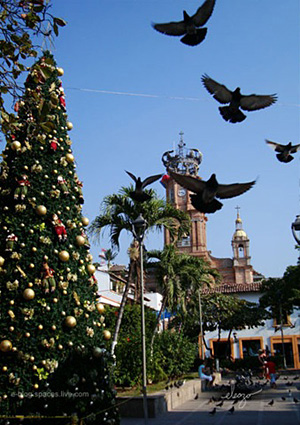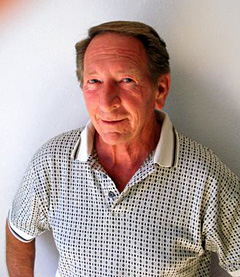Five centuries ago, Christmas was virtually nonexistent in Mexico; in fact, Christianity had not even been introduced to the New World. The native Aztec Indians weren’t even aware of the concept of Christianity until 1524, when Twelve Franciscans (Twelve Apostles of New Spain) came to Mexico; about a decade later, the Dominicans followed.
Soon after the arrival of the Twelve Franciscans, some of the native Indians began accepting the story of Christ and converting to Christianity. One such Indian, an indigenous farmer named Cuauhtlatoatzin (the talking eagle in the Nahuatl language) living north of what is now known as Mexico City, claimed to have witnessed an apparition of the Virgin Mary on Tepayac Hill.

Our Lady of Guadalupe, as the Virgin Mary came to be known, is to this day recognized as the Patron Saint of all the Americas and is the basis for much of the Catholic faith throughout Mexico. As an example, the most predominate historical landmark in Puerto Vallarta is the Our Lady of Guadalupe church in El Centro.
Evidently the Franciscans were quite impressed with their new convert; they moved him and his wife into their new mission and changed his name to Juan Diego (a bit easier for them to pronounce!). After Juan Diego witnessed the mystical Lady on Tepayac Hill who supposedly cured his uncle of a terminal illness, the rest of the local Indians reasoned that it must be an awfully good religion that these intelligent Spaniards had brought to them; they soon dumped their ancient pagan beliefs in favor of the new Catholic Church teachings. With the miracles that these Spanish God-like Fathers had to offer, it took the Franciscans only six years to sign up the first eight million new believers!
Soon after news of Juan Diego’s apparition made its way around Mexico, the native Indians reconciled (a polite way of putting it!) with the Spaniards and a new race of people, the Mestizo, was created. In fact, the Lady of Guadalupe is generally depicted as a Mestiza. Today, it is estimated that anywhere from 60-80% of the Mexican population is Mestizo and slightly more than 90% of all Mexicans are Catholic. With well in excess of 100 million Catholics, Mexico ranks second only to Brazil with its population of Roman Catholics.
During the 20th century, the Mexican government took a number of steps to separate church from state and also nationalized much of the wealth that the church had accumulated over the years; however Catholicism continues to have a strong influence in Mexican life today. Although it’s influential, it’s certainly not forced on anyone or even on display. In our 13 years of living in Vallarta, we’ve never noticed a priest or nun in the city; they do not wear their habits in public.
Many of the annual Mexican fiestas are religious by nature but Easter and Christmas are the most widely celebrated. We have been fortunate enough to witness the past 13 Christmases in PV and can say that it’s a sight to behold! They start the season early in December by hanging colorful lights and decorations throughout the city. The official holiday season begins on December 12th, the birthday of the Lady of Guadalupe, and lasts until January 6th with Epiphany or Los Reyes Magos (the day of the three kings or wise men); some now refer to this holiday season as the Guadalupe-Reyes Marathon!
Approximately 9 days before Christmas, various processions, called Las Posadas, are initiated in surrounding cities and communities as the participants begin their walk to Puerto Vallarta. These processions are a celebration of Joseph and Mary’s search for shelter in Bethlehem and they all convene in El Centro on Christmas Eve at the Our Lady of Guadalupe church. The children have their colorful piñatas and the adult celebrations begin as the entire downtown area bustles with activity and music. Christmas Day is a much more quiet and somber day; a day of recovery!
December 28th is the Day of the Innocents, the equivalent of April Fool’s Day in the United States; a day when everyone plays practical jokes on each other and not an appropriate time to “loan” money or believe anyone!
Of course, December 31st is another joyful occasion in Vallarta. The entire perimeter of Banderas Bay lights up with incredible fireworks displays lasting almost a half an hour and fiestas can be heard all night long throughout the city; you’ll not see a more spectacular New Year’s Eve celebration. Of course, New Year’s Day is another quiet day as everyone again tries to recover!
The final Christmas season fiesta is that of Epiphany on January 6th celebrating the arrival of the Three Wise Men. The children receive gifts and everyone enjoys a pastry called La Rosca De Reyes (bread of the kings). Typically, there is a very small doll buried in the bread roll and the person that gets the piece containing the doll is responsible for hosting the next fiesta on February 2nd, the Day of Candlemas. (You’ve got to give them credit; they have plenty of reasons for planning the next fiesta!)
Now you know why they refer to Christmas Season as a Marathon! By the way, in Mexico, it’s never referred to as “Winter Solstice Holidays”, “Non-Denominational Festivities Season”, or by any other politically correct term; it’s Christmas Season!
It should be mentioned that there are a few things obviously missing in Puerto Vallarta during this season of celebration. Beautiful snow covered pine trees and deep snow drifts for Santa’s sled are nowhere to be found; of course, they were probably also lacking 2,000 years ago in Bethlehem! The average daily low temperature during the holidays is 65°F and the average high temperature is 80°F, resulting in the average daily temperature for this festive season of 72°F with clear blue skies and zero chance of rain; it just doesn’t get any better than this!
If you want your surroundings to look more like that to which you’re accustomed, you can purchase all sizes of artificial Christmas trees at Sam’s Club, Costco, Home Depot, or Wal-Mart; better yet, you can just hang your lights all over the beautiful palms. Finding poinsettias for that additional touch of Christmas ambiance is not a problem; after all, poinsettias are indigenous to Mexico and are abundant in Vallarta. Throw in a few bougainvilleas, hibiscus, birds of Paradise, geraniums, orchids, and numerous other tropical flowers (all in full bloom over the holidays) and you’ll have the most beautiful Christmas you’ve ever experienced.
So, what are you waiting for? Vallarta’s a short 2-3 hour flight from most US cities, it’s a simple and relatively inexpensive way to enjoy the best holiday season of your life. With perfect weather, very hospitable, gentle, and courteous English speaking locals inviting visitors with open arms, clean water and food, safety and security a major priority, and fun galore, you’ll not have a Merrier Christmas anywhere; as they say south of the border, Feliz Navidad!

The founder of Puerto Vallarta Real Estate Buyers’ Agents (PVREBA), Jim Scherrer is a retired entrepreneur who has owned property in Puerto Vallarta for more than 25 years. Utilizing his experience and extensive knowledge of the area, Jim’s series of informative articles about travel to and retirement in Puerto Vallarta reveal the recent changes that have occurred in Vallarta, while dispelling the misconceptions about living conditions in Mexico.
For more articles by Jim Scherrer, click HERE or visit PVREBA.com.




